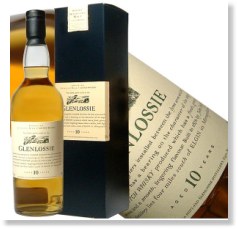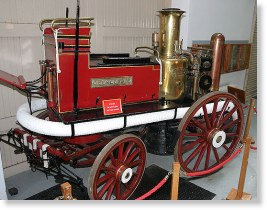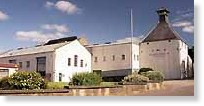| Glenlossie
Single Malt Scotch Whisky
Glenlossie Distillery
Elgin Morayshire IV30 3SS Scotland
Tel: +44 (0)1343 860331 / Fax: +44 (0)1343 860302
Viewer's Comments about Glenlossie
 Glenlossie Distillery was establishsed in 1876 by John Duff,
tenant of the Fife Arms, Lhanbryde, Morayshire. Duff who worked
several years as a manger at the Glendronach
Distillery was described by The Aberdeen Journal
in 1877 as the "great moving spirit" of the enterprise.
The distillery was built in partnership with Duff's friends,
H.M.S. Mackay, burgh surveyor and the local procurator fiscal,
Alexander Grigor Allan and their business was known as John
Duff and Co.
Glenlossie Distillery was establishsed in 1876 by John Duff,
tenant of the Fife Arms, Lhanbryde, Morayshire. Duff who worked
several years as a manger at the Glendronach
Distillery was described by The Aberdeen Journal
in 1877 as the "great moving spirit" of the enterprise.
The distillery was built in partnership with Duff's friends,
H.M.S. Mackay, burgh surveyor and the local procurator fiscal,
Alexander Grigor Allan and their business was known as John
Duff and Co.
The plan for the distillery was sketched out by John Duff
in conjunction with an Elgin architect, A. Marshall Mackenzie.
The Aberdeen Journal was favourably impressed by
"the adaptation of the buildings to the natural rise
and fall of the ground...which will allow the work to be accomplished
with a much smaller staff than in a place which has not the
same facilities for bringing gravitation into operation".
It noted "the abundance of excellent water to make the
whisky and drive the machinery, thereby rendering the place
independent of steam power". There was a fall of about
70 feet (21 metres) from the large dam which provided the
force for a water wheel of 8 horse power to drive the machinery.
Alfred Barnard described Glenlossie in The Whisky Distilleries
of the United Kingdom, 1887: "It stands at the foot
of a fir-clad hill and consists of a double oblong range of
buildings, and with the exception of the Distillery House
(which is built of stone) is constructed entirely of cement,
which under the sunlight as we descended the hill, looked
beautifully white and clean." The cement had been made
from sand and gravel carted from the River Lossie.
At the time of Alfred Barnard's visit, John Hopkins &
Co. Ltd., Glasgow, blenders of Old Mull and Glengarry Scotch
whiskies, were entirely responsible for the sale of the sale
of the make, and Hopkins himself was a partner. Annual output
was then 90,000 gallons (409,000 litres).
John Duff & Co. was liquidated in 1896 after Allan's death
and Duff's departure. It was reformed as the Glenlossie-Glenlivet
Distillery Co. Ltd. and floated on capitalisation of 5,000
Ordinary shares of £1 each and 5,000 Preference shares
of £10 each. When these were offered for public subscription,
applications were received for 12,620 Ordinary and for 23,266
Preference shares. H. M. S. Mackay, now the local agent for
the North of Scotland Bank, for the Northern Assurance Co.
and the Commercial Union, was the senior director. His co-directors
were his nephew, J. H. Hair, who was to be managing director
for many years, and A. M. Gregory, formerly of Glen
Albyn Distillery, Inverness. Much of Mackay's time was
devoted to public affairs, notably as vice-convenor of Moray
Country Council.
The Glenlossie-Glenlivet Co. was efficiently managed. The
expense of carting incoming supplies and consignments of whisky
between the distillery and Longmorn Station, on the railway
line that ran from Elgin to Perth via Grantown, ceased to
be a burden when a private siding was built in 1896. New warehouses
were built and extension or improvements effected in almost
every year up to 1917, when all malt whisky distilleries were
closed by Government order in the interests of conserving
barley for foodstuffs during WWI. Glenlossie started up again
in 1919, the year when Scottish Malt Distillers Ltd., a subsidiary
of The Distillers Company Limited, obtained a controlling
interest in the Glenlivet-Glenlossie Co. That company wound
up in 1930 since the distillery had been worked as a unit
of SMD. Today, the Glenlossie Distilley is owned by Diageo.
A severe outbreak of fire on 6 March 1929 caused damage to
the extent of £6,000. As a result, the distillery ceased
operations for the remainder of the season. In common with
almost all malt whisky distilleries, Glenlossie closed down
for the greater part of the WWII - once again due to government
restrictions on the supply of barley for distillation.
As soon as building controls were relaxed, SMD began a programme
for increasing distilling and storage capacity on the site
of 25 acres (10 hectares). No. 3 warehouse was built in 1955,
followed by a Group warehouse erected in three stages which
took place in 1960, 1965 and 1975.
Water ceased to be a source of power in 1919, followed by
steam in 1960 when all machinery in the distillery was converted
to electricity. The same year, the four hand-fired stills
were converted to a mechanical stoker system. The stills were
increased to six in 1962 and converted from coal heating to
steam heating from an oil-fired boiler in 1972.
A characteristic of the process carried out at Glenlossie
is the installation of a purifier between the lyne arm and
the condenser on each of the three spirit stills. This technique
tends to increase the still's rectifying ability and has a
bearing on the character of the spirit produced. It is not
used at Mannochmore Distillery,
which was built on part of the same site in 1971. Both distilleries
use the same water supply -- process water from the Bardon
Burn, which has its sources in the Mannoch Hills, and cooling
water from the Wedlock Burn and the Burn of Foths. However,
they are separate distilleries and each work alternately to
produce two distinctive Speyside malt whiskies. Mannochmore
is equipped with three wash stills and three spirit stills,
heated by steam.
A plant for the production of dark grains, a high-protein
animal feedingstuff, from the solid matter left over from
the mashing and distillation processes, was built in 1969
and doubled in size when Mannochmore Distillery was built.
Scottish Malt Distillers Ltd. owns 21 houses which is occupied
by employees at both distilleries. SMD also owns and manages
Glenlossie Farm, Easterton Farm and Wardend Farm. These farms
which occupy an area of about 500 acres (202 hectares) produces
barley, turnips and beef cattle.
 The Glenlossie Fire Engine 1862
The Glenlossie Fire Engine 1862 |
Glenlossie Distillery houses a Shand Mason & Co. fire
engine made in 1862. The same year, it won a prize in the
International Exhibition held at the Crystal Palace. It
was pulled by a pair of horses and could raise steam in
about five minutes. The last time this engine was used was
for the fire of 1929.
Whisky from the Glenlossie Distillery is highly prized by
blenders and is consequently extremely rare to find as a
single malt. Its single malt is rarely bottled (only 0,5%
of the production is marketed as single malt) and it can
be purchased at independent bottlers such as Berry Bros
& Rudd and Gordon and MacPhail.
The Glenlossie Distillery produces a lighter, more delicate
whisky. Michael Jackson describes its house style as "flowery,
clean, grassy, malty. Aperitif."
Courtesy of Diageo Scotland
|
Nose: The nose is
elegant and rather redolent of a Lowland malt, showing
notes of freshly cut-grass, white flowers and citrus
notes.
Palate:
On the palate, the hints of tangerine and ripe pineapple
fruit are dominant, on a background of spices and
honey.
Tastings Notes by
Berry Bros & Rudd |
Nose: Sweet with floral
aromas. Some spicy notes with a rich, dried fruit
element.
Palate:
Sweet, smoky with a very rich mulled fruits and dark
chocolate element. Drying out with sherry oak tones.
Nose: Fragrant
- lavender and rose scent. Sherry wood with hints
of nuts and chocolate.
Palate:
Smoky, sweet chocolate notes with rich fruits - raisins
and sultanas. Again drying with spicy and oak flavours.
Finish: Dried
fruit, slightly smoky.
Tasting Notes by
Gordon & MacPhail |
|
|
|
|
The
Glenlossie Distillery

Nestling in the fertile Laich of Moray and
only two miles from Milbuies nature reserve, the hills and
farmland surrounding Glenlossie and the Mannochmore distilleries
are rich in wildlife, including the long-eared owl and the
great spotted woodpecker which have been adopted as the
symbols of the distilleries.
Glenlossie was built in 1876 by John Duff and his partners
H.M.S. Mackay and Alexander Grigor Allan. A warehouse was
added in 1955 and additional ones in 1960, 1965 and 1975.
In 1962 the stills were increased from four to six and in
1963, new larch were washbacks installed. The stills were
converted to steam heating by oil fired boilers in 1972.
The current annual output is 2.2 million litres of alcohol.
The Glenlossie Distillery is operational however, it does
not have a visitor center.
Courtesy of Diageo Scotland |
|

